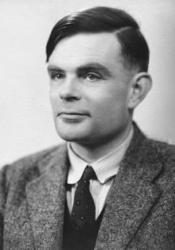Alan Turing, “Computing Machinery and Intelligence” (1950)
In his seminal work in theoretical computer science, Alan Turing addresses the question, “can machines think?” Arguing that popular conceptions of “thought” are too ambiguous to discuss scientifically, Turing claims that the appearance of thought is not only easier to determine than internal ideation, but also a sufficient basis from which to assume that the machine is “thinking”.
Further, Turing proposes an experiment to determine if a machine can “think”. In this imitation game, commonly referred to as the Turing Test, a human judge attempts to distinguish a human from a machine. The judge asks natural language questions to both subjects through a monitor, and must determine each subject’s identity by their responses. These text responses are the only information that the judge is given. As such, the external appearance or vocal ability of the machine is not considered. Under this situation, if the machine is able to convince a human judge of its humanity a significant percentage of the time, Turing argues that the machine can “think”.
Turing does not argue that these “thinking” machines would be capable of humanness, but rather that they would be capable of imitating human behavior to such a degree that they would be indistinguishable from humans. At this point, he argues that we must treat the machine as a thinking being; given that we treat other humans as capable of thought based solely on external observations, we must give the same benefit of the doubt to an imitating machine.

